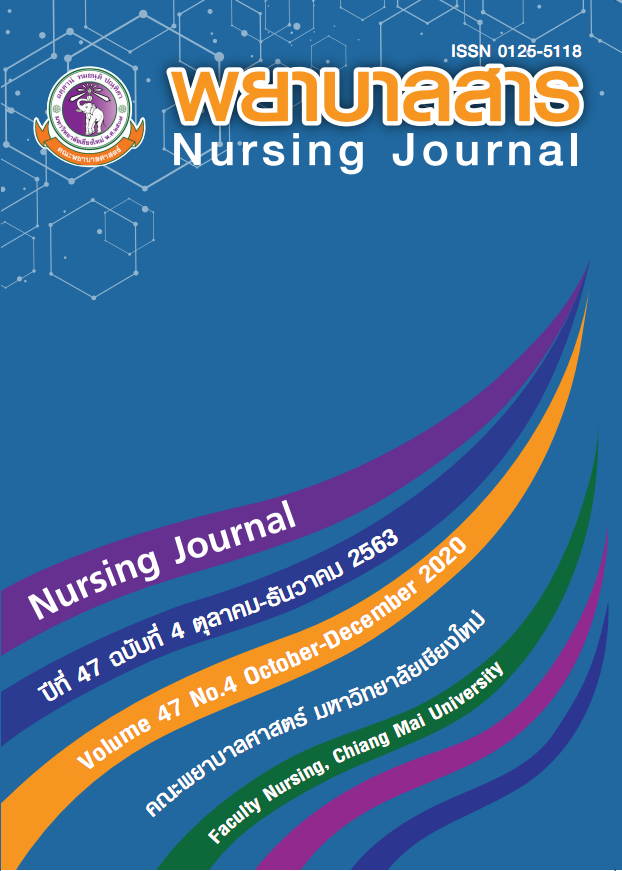Development of an Information Provision Model for Cancer Patients’ Relatives, Male Medical Ward, Buddhachinaraj Phitsanulok Hospital
Keywords:
Information Provision, Cancer Patients’ RelativesAbstract
Providing information to relatives of cancer patients who need palliative care create good
quality of life of patients and families. The purpose of this study was to develop of an information
provision model and to explore the outcomes of information provision model for cancer
patients’relatives of the Male Medical Ward, Buddhachinaraj Phitsanulok Hospital by applying the
FOCUS-PDCA continuous quality improvement process (Batalden & Stoltz, 1993). The population
included 20 registered nurses. The sample included 35 cancer patients’ relatives. The instruments
used in this study were: 1) interview guidelines of information provision for cancer patients’
relatives, 2) an information provision manual, 3) an observation checklist for information provision
practice for cancer patients’ relatives, 4) nurse satisfaction questionnaire regarding the information
provision model, and 5) cancer patient’relatives satisfaction questionnaire regarding receiving
information. The instruments were confirmed by three independent experts. The content validity
indexes of the nurse satisfaction questionnaire regarding the information provision model and of
the cancer patient’relatives satisfaction questionnaire regarding receiving information were 1.00
and .95 respectively. The inter-rater agreement indexes by 2 sets of observers were .99 and 99.
respectively. Frequency, percentage, mean, and standard deviation were used for data analysis.
The study results revealed that 1) information provision model included personnel responsible
for information provision, location for information provision, equipment and media for information
provision, time for information provision, information for cancer patients’ relatives, and process ofinformation provision; 2) Outcomes of the information provision model were: more than 80% of nurses were able to completely implement the information provision model, more than 80% of
nurses were satisfied with the information provision model at high or highest levels, and more than80% of cancer patients’ relatives were satisfied with the information they received at high or
highest levels. Results of this study revealed that the information provision model can be used to
provide information for cancer patients’ relatives effectively. Therefore, nursing administrators
should continuously supervise the implementation of the information provision model.
References
Batalden, P. B., & Stoltz, P. K. (1993). A framework for the continual improvement of health care:building and applying professional and improvement knowledge to test changes in daily work. The Joint Commission journal on quality improvement, 19(10), 424-447.
Becker, M. H., & Maiman, L. A. (1980). Strategies for Enhancing Patient Compliance. Journal of Community Health, 6(2), 113-135.
Boonnun, J., & Chayaput, P. (2009). Nurse’s Role in Unfavorable Information “Breaking Bad News” Communication to Cancer Patients. Thai Journal of Nursing Council, 24(3), 7-19. (In Thai)
Buddhachinaraj Phitsanulok Hospital. (2016). The statistical data of Male Medical Ward Buddhachinaraj Phitsanulok Unit. Phitsanulok: Buddhachinaraj Phitsanulok Hospital.
Clayton, J. M., Hancock, K. M., Butow, P. N., Tattersall, M. H., & Currow, D. C. (2007). Clinical practice guidelines for communicating prognosis and end-of-life issues with adults in the advanced stages of a life-limiting illness, and their caregivers. The Medical Journal of Australia, 186(12), 77-105.
The Healthcare Accreditation Institute. (2003). Patient safety: Concept and practice. Bangkok: Design. (In Thai)
Henneman, E. A., & Cardin, S. (2002). Family-centered critical care: a practical approach to making it happen. Critical Care Nurse, 22(6), 12-19.
House, J. S. (1986). Social support and the quality and quantity of life. Research on the Quality of Life, 253-269.
Lazarus, R. S., & Folkman, S. (1984). Stress appraisal and coping. New York: Spring.
Lemongkol, S. (2015). Nurse’s Role in Palliative Care. In Intarasombat, P. & Gasemgitvatana, S.(Eds.), Skills Development Guide for Nurses in End of Life Care (pp. 67-83). Bangkok: Thailand Nursing and Midwifery Council and The Nurses’ Association of Thailand. (In Thai)
Leske, K., & Coon, C. (2002). The Development of feedstuff retainable phosphorus values for broilers. Poultry science, 81(11), 1681-1693.
Nantachaipan, P., & Soivong, P. (2014). Clinical Nursing Practice Guidelines: Palliative Care in Adult Patients. Bangkok: Judthong. (In Thai)
Nilmanat, K. (2012). The End of Life Care. Songkhla: Chanmuang Press. (In Thai)
Rome, R. B., Luminais, H. H., Bourgeois, D. A., & Blais, C. M. (2011). The Role of Palliative Care atthe end of life. The Ochsner Journal, 11(4), 348-352.
Sanathum., Y. (2012). Quality Improvement of Information Provision Process for Pre-operation patients, Phrae Hospital (Independent Study, Chiangmai University). (In Thai)
Supachutikul, A. (2000). Quality Development Tools. Bangkok: Design. (In Thai)
Suwannasuan, W., Thungjaroenkul, P., & Chitpakdee, B. (2017). Quality Improvement of Nursing Documentation in Nakornping Hospital, Chiang Mai Province. Nursing Journal, 43(3),128-136. (In Thai)
Tsao, M. W., Pfeifer, K. H., Rabolt, J. F., Castner, D. G., Häussling, L., & Ringsdorf, H. (1997). Formation and characterization of self-assembled films of thiol-derivatized poly (dimethylsiloxane) on gold. Macromolecules, 30(19), 5913-5919.
Twibell, R. S. (1998). Family coping during critical illness. Dimensions of Critical Care Nursing,17(2), 100-112.
Van Cutsem, E., Cervantes, A., Adam, R., Sobrero, A., Van Krieken, J. H., Aderka, D., ... Ciardiello, F.(2016). ESMO consensus guidelines for the management of patients with metastatic colorectal cancer. Annals of Oncology, 27(8), 1386-1422.
World Health Organization. (2012). WHO definition of palliative care. Retrieved from http://www.who.int/cancer/palliative/definition/en/
Downloads
Published
How to Cite
Issue
Section
License
บทความที่ได้รับการตีพิมพ์เป็นลิขสิทธิ์ของวารสารพยาบาลสาร
ข้อความที่ปรากฏในบทความแต่ละเรื่องในวารสารวิชาการเล่มนี้เป็นความคิดเห็นส่วนตัวของผู้เขียนแต่ละท่านไม่เกี่ยวข้องกับมหาวิทยาลัยเชียงใหม่ และคณาจารย์ท่านอื่นๆในมหาวิทยาลัยฯ แต่อย่างใด ความรับผิดชอบองค์ประกอบทั้งหมดของบทความแต่ละเรื่องเป็นของผู้เขียนแต่ละท่าน หากมีความผิดพลาดใด ๆ ผู้เขียนแต่ละท่านจะรับผิดชอบบทความของตนเองแต่ผู้เดียว






